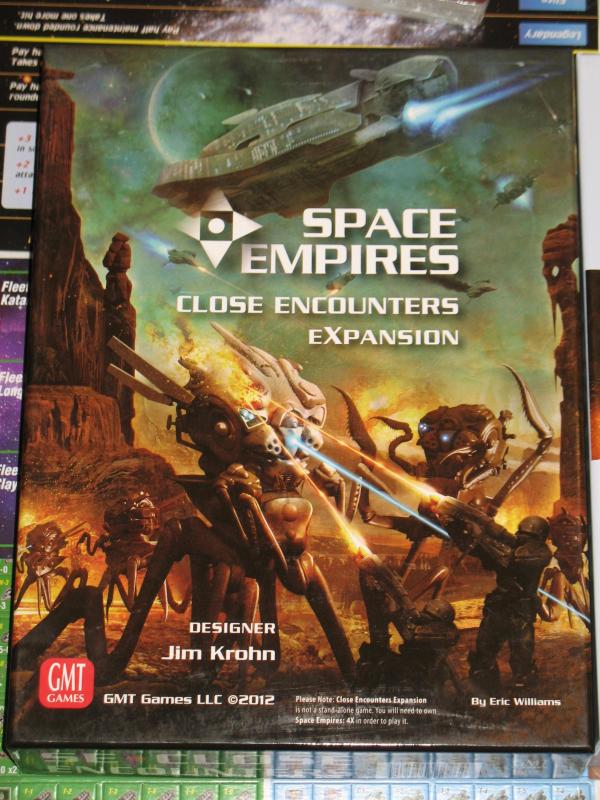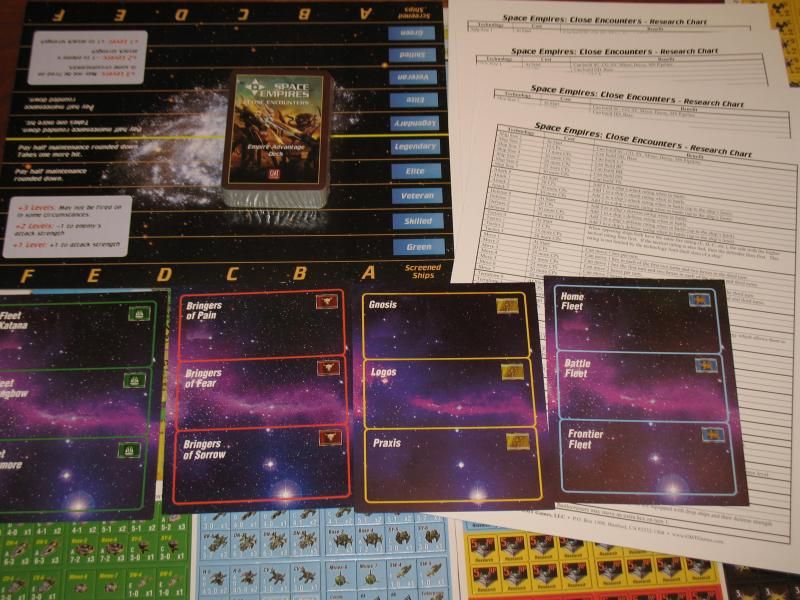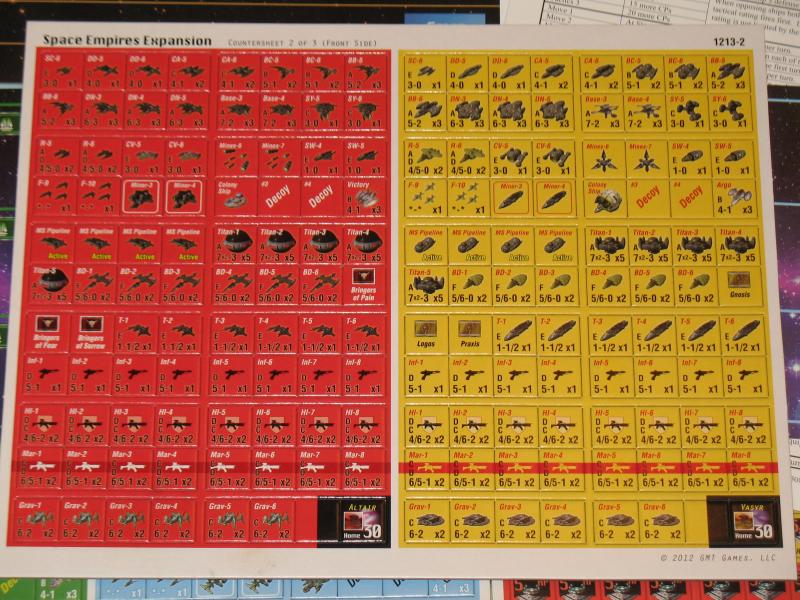 This is an expansion to what is one of the best space games on the market. It is positively loaded with new ships and technologies and the counter sheets are gorgeous. Given that everything in this set is designed to tune and develop aspects of the original game, the new rules and additions can be viewed as being sort of a critique of the core set. (After all, if the original game was giving people the exact experience the developers wanted, why would they feel the need to tinker with it?!) As someone that has played the vanilla version of the game extensively, I will give my opinion on each section and explain whether it actually adds something to the game or not. Given the number of space games that have ended up collapsing under the weight of their own cruft and add-ons over the years, this is actually something that it hard to get right– so let’s take a hard look at these changes.
This is an expansion to what is one of the best space games on the market. It is positively loaded with new ships and technologies and the counter sheets are gorgeous. Given that everything in this set is designed to tune and develop aspects of the original game, the new rules and additions can be viewed as being sort of a critique of the core set. (After all, if the original game was giving people the exact experience the developers wanted, why would they feel the need to tinker with it?!) As someone that has played the vanilla version of the game extensively, I will give my opinion on each section and explain whether it actually adds something to the game or not. Given the number of space games that have ended up collapsing under the weight of their own cruft and add-ons over the years, this is actually something that it hard to get right– so let’s take a hard look at these changes.
—
The Basic Expansion Rules
These sections are meant to be added into the base game more or less as a unit. Not all of them are immediately attractive, but looking at them more closely, it’s evident that there is more than a little synergy here.
New Homeworlds — Given that there is so much more tech to choose from and more units to buy, the income of the home worlds have been raised from 20 to 30 CP.
Ship Experience and Military Academies — I did not think I would care for this at first, but upon reflection… being able to have Elite, seasoned units go after Green crews that man newfangled vessles that are fresh out of spacedock and under a temporary disadvantage even though their tech might be top of the line… that is a really good situation that I’d love to see emerge in the course of play. I wondered at first that the additional bookkeeping might be prohibitive, but since you’re already tracking tech level on a counter by counter basis, my attitude now is more along the lines of “why not?!” I have never seen a gamer fail to keep up with their experience points, regardless of the system. On the other hand, I never played enough BattleTech to see my mechwarriors level up in any significant way. This new rule not only gives me that, but it also adds even more incentive for players to play aggressively. This looks like a Good Thing™.
Boarding and Capturing Ships –Conducting a raid operation in Space Empires 4X is chancy due to the fact that you get so far from your own space docks. But with boarding ships along, you can continue to “grow” your fleet even while deep in enemy territory! The effectiveness of these units can be blunted with security forces technology, but it doesn’t look like they can be made completely irrelevant the way that fighters and raiders are when they’ve been sufficiently countered. The way that captured ships immediately drop to the “Green” experience level is flavorful. The choice between using your enemy’s ships against him and scrapping them for “free” tech levels adds in another non-obvious decision to the game. If you thought the combat system was a little bland before, this really looks like something that can really add a lot of color.
Titans — Okay, this is a unit that makes me wonder how I could have played so many games with just the core set. The titan can take massive amounts of punishment. It does double damage on its hits. It can carry fighters. It can blow up planets. While there are no thermal exhaust ports on this thing, fighters do get just enough an edge against them that it may be worth it to invest in them for planetary defense forces even late in the game. Whatever you use to fight these things, you’ll need a lot of them. The existence of this ship in the game combined with the extra money on the home worlds will inspire a lot more players to go for the “big ship” strategy.
Fleet Markers — These have no effect on the rules, but they do make it easy to keep up with large stacks of counters. Keep your three biggest task forces off map on fleet cards and just use the markers on the main hex map.
Mine Sweeper Technology — Evidently mines were imbalanced in the core set as their cost for their technology has been increased here while the cost of mine sweeper technology has been reduced. A new level of mine sweeper technology has been added, allowing them to remove three mine markers before the detonation phase.
Movement Technology — Perhaps in a move to encourage even more interaction and aggressive play, the cost of movement technology has been reduced and another movement tech level has been added that will allow ships to move three hexes in each of the three turns between production phases.
Reaction Movement — If lowering the price doesn’t get people to invest in movement tech, then maybe this will be able to sweeten the deal enough to get people to pull the trigger on it. Units that are equipped with Exploration-2 technology are able to respond to enemy attacks by sending ships into neighboring hexes where an opponent has initiated a battle. The higher the movement technology your ships are equipped with, the larger the ships can be that are able to make the move. (There are relatively complex rules for this sort of thing in Federation & Empire, but these look fairly easy to learn and apply in comparison.)
Fast Battlecruisers — Scouts can get point defense. Destroyers can get scanners. Cruisers can get special senors that make exploration safe and reaction movement an option. But battlecruisers didn’t have anything to really differentiate them in the core set… and people that would buy the tech to build them had littler reason not to pass them over in order to invest in even bigger ships. That gets fixed here because this technology gives these units an additional move on turn one. This small change combined with the reaction movement rule does a lot to add flavor and utility to the mid-sized starships of the game.
Alien Technology — In the core game, it’s debatable whether or not it’s worth it to invest in terraforming technology and go out into deep space to take over some of the stray barren planets that are out there. Especially if you are playing with the non-player aliens, it’s hard to sacrifice ships on this when you could be burning through your opponents’ colonies. Well these cards give a little something extra to people that dare to “explore strange new worlds.” You draw two and keep one when you successfully colonize an alien world. While none of these perks will necessarily win you the game in and of themselves, they can give you a significant edge and give you an excuse to buy ship classes that you don’t tend to rely on as much.
Empire Advantages — As if there isn’t enough variety here already, these cards will ensure that each player empire has its own feel. By giving each player a different advantage, everyone is encouraged to do something outside the scope of their usual preferred strategies. If your opponents are starting to get predictable, this one rule could ratchet back up the tension inherent in first contact engagements.
Just looking these over here, I have to say that this looks like a very strong combination of modifications. Mines are dialed back while cruisers and battlecruisers gain new abilities. That’s a very modest adjustment that feels right. The experience system and the alien technology cards provide even more flavor and do even more to reward aggressive play. The boarding ships add one more dimension to the paper-rock-scissors type interaction of the big fleet battles while creating both the potential for entertaining combat results and shortcuts to gaining new technology on top of that. Larger home worlds and cheaper movement tech does even more to help get the game going in the early stages– something I occasionally hear complaints about. Basically everything that could possibly be perceived as being a drag in the core set is getting addressed in some manner here. Nothing in this section seems out of line or overdone, either.
The Advanced Expansion Rules
We have already reached the outer limits of what I can reasonably expect to explain, teach, and manage with all but the most dedicated gamers. The core set shows no signs of getting stale for me and the basic expansion rules above look like they’re well worth the effort. I’m keen on playing them, anyway. The best thing about them is that they look to be reasonably playable; I expect that they add depth, flavor, and richness without necessarily adding a lot of weight. Admittedly, convincing an actual opponent that such is the case is not a given. Yet the rules do address real weaknesses in the game play that I was inclined to hand wave, work around, and ignore in my games with the core set. There’s nothing left to add now, right? Or is there…?
Let’s see about that.
Transports and Ground Combat — I have mixed feelings about these optional rules. On the one hand, these aren’t just run of the mill generic “army” units from games like Risk. You have infantry, militia, space marines, heavy infantry, and grav armor to play with. The on-world combat system is almost as well defined as the basic space combat rules from the core game. BUT… adding in these units and the transports it takes to ferry them around is something that will significantly add to the complexity of the game. A playing time of two to four hours was already the upper limit of what I can tend to manage with people. Don’t get me wrong, this stuff is right up my alley; I just imagine myself having to find my gaming soul mate in order to get this option into actual play.
Captured Colonies — But the designer is well aware of the fact that this is a hurdle and at least tries to sweeten the deal enough to make me bite the bullet here. (They’ve done it before, after all.) Can the ground combat system pull its own weight? Well, if you’re going to go through the hassle of loading up troop transports and trucking them across the galaxy, it better do something for you that nuking people from orbit doesn’t. The first big perk here is that conquering a world immediately provides an economic benefit. You can expect to gain 3 CP from it on the following income phase instead of going through the usual 0-1-3-5 development sequence. You also don’t have to coordinate sending a slow poke colony ship along with your task force. Capturing any of an opponent’s worlds lets you look at his Empire Advantages and Alien Technology cards. You also get to see his production sheet. (That’s huge!) Finally, you gain two “free” technology levels if the world is from his home system and one if the world was in deep space.
Flagships — In the original prototype for the game, Jim Krohn’s group would actually name every single ship in play, writing it directly on the counter. It took a week to play their monster space game and this is one of the things that had to go when he got to work making it into something playable by mere mortals. Reviving that old system somewhat, each empire is given a single “name-level” unit with this rule. The rules for these look to be inspired from the Enterprise’s role in the star fleet of Star Trek: The Next Generation. I’m not particularly wild about arbitrarily handing players a big ship before they’ve earned it, but it would be fun to demoralize someone by capturing or destroying their irreplaceable flagship. Of course, knowing the psychology of the typical gamer, I wouldn’t expect them to want to play with me again after that!
Research and Industrial Centers — This rule doubles the potential productivity of the colony worlds. I can’t even begin to wrap my head around this. The problem this rule is supposed to address is in how you tend to stop developing tech at some point in order to produce massive amounts of ships for the final big blowout battle. This rule limits you to spending 15 CPs a turn on technology unless you specifically dedicate a colony’s “bonus” production towards research. I haven’t really seen this as being a problem that needed to be solved, but this is obviously something that other groups have wanted to tinker with. Even the core set has an optional rule addressing this, so this is evidently a well known problem with the game.
Terraforming Nebula — I like this rule. This one’s for the people that want to set up a more personalized economic system before their opponents blow it up. It adds more money to the game, but it’s expensive enough to engineer that it feels balanced. I’m curious as to whether people go to the trouble to set these up in the deep space area or not.
Unique Ships — If you feel like a particular ship type should be in the game, you can pretty much bring it to the table through this rule. I’m kind of partial to the casual carriers you could make with this. Being able to create a Super Star Destroyer with a tractor beam looks fun. And yeah, this is just one more way that you can make your own special snowflake space empire that’s different from everybody else’s. But my gut feeling on this is that nobody will like losing a four hour game to someone that can get cutesy with this particular rule. It obviously covers a tremendous range of options, but I’m skeptical of how it’d work in actual play.
—
Of these advanced expansion rules, I see ground combat, flagships, and nebula mining as being the ones that I’d expect to get the most use. There are a couple of nuances to the ground combat rules that look like it would make the “short game” victory conditions a lot more interesting, so that’s liable to be the place that they will make their debut. The rest, I don’t expect to see play outside of the solitaire scenarios.
And… as with just about everything else with this game… the designers and developers seem to have anticipated that. There are several new scenarios here, including a solitaire Alien Empires game with flowcharts that let the “AI” use all of the goodies in this expansion. There are also cooperative variants to both this and the Doomsday machine games. This not only provides an option for playing the game with people that can’t otherwise stomach a lot of direct conflict, but it also allows players a chance to work together to “beat the game” while they are learning how all the rules work. That’s the kind of nicety that increases the chances of people asking to play again.
No matter which pieces of this set end up in your sessions, it’s clear that a lot of care has gone into developing material that deal with things that come up in actual play. There are enough ways to put this expansion to work that it is sure to give you your money’s worth, assuming it sounds like it is up your alley in the first place. And best of all, everything but the craziest optional rules here are lean and mean, adding more to game play than it takes to deal with it. (A lesser designer would have gone overboard with stuff that would slow the game down to a crawl.)
I never expected to see GMT get into the space gaming scene. They’re better known for their “serious” war game designs for “adults.” Fortunately for the people that never outgrew the need to explode gigantic starships, GMT has really brought their A-game here and pushed the state of the art in strategic space gaming forward by a giant leap. I’m blown away.
after reading this I want to go home and play Space Empires.
This sounds like a great game. One quibble – mines. Are minefields set up to surround a planet or other fixed object in space? I could never stand how Federation and Empire would allow minefields to be a barrier between two star empires, free floating in space.
I purchased the base game on your first review to help pass the time overseas. If my brothers like it as much as I do when I get back I’ll get the expansion too. While I’m initially not keen on the idea of ground troops, it might be fun to carry out those combats with WH40k skirmishes, using Space Empires as a campaign.

